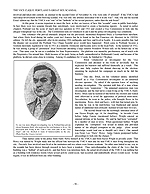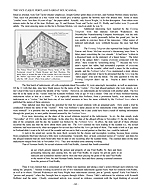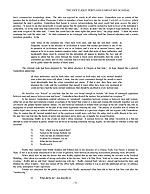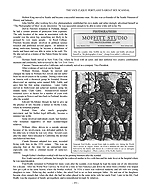The Vice Clique: Portland's Great Sex Scandal
By George Painter
 The Vice Clique: Portland's Great Sex Scandal by George Painter is available for $25 through On Demand Publishing and Schuler Books, schulerrbooks.com
The Vice Clique: Portland's Great Sex Scandal by George Painter is available for $25 through On Demand Publishing and Schuler Books, schulerrbooks.com
The Vice Clique scandal occurred in Portland in 1912, when 68 men were implicated in the "crime" of consensual sex. Painter's book follows all 68 cases to the extent possible, and examines the scandal's impact on individual lives, and the impact it had on Oregon law and culture for approximately the next 100 years.
The 8.5"x11" (approximately) book contains 296 pages, which includes 2 pages of bibliography and 45 pages of footnotes. There are 64 photographs from archival sources and from the author's personal collection.
Scroll down on this page to see sample pages from the book, and to read a full review.
Click on any of these pics to see full-size sample pages. |
|||
 About the book:
About the book:
By Robin Will
1912 was an election year in Portland, Oregon, and for neither the first nor the last time, the topic of vice was being raised in public discussion.
A young man with political aspirations – a volunteer investigator on the city's newly-formed Vice Commission – had, on information provided by an elevator boy, located somebody at the YMCA who didn't seem quite right, and turned his name over to police.
Meanwhile in the juvenile court, a 14-year-old boy arrested for shoplifting offered the defense that he had been sexually corrupted by a number of men, and started naming names. (It was never explained how sexual experience could lead to shoplifting.)
The two events opened the door for an investigation that eventually implicated 68 Portland men in the crime of consensual sexual activity.
Contradicting the popular notion that homosexuality occurred only among the lower classes, "the vice clique," so named by the Oregon Journal, included workingmen and some members of Portland's professional community. Three of Portland's daily newspapers reported the scandal responsibly, while the fourth, The Portland News, seemed obsessed with the nastiness, serving up a diet of speculation, innuendo, and plain old falsehood. Oregon's justice system lumbered into action.
In the end, only one man went to prison. Two more served time in the county jail. Some men were given the opportunity to leave town, others were never charged. Certainly, lives were changed and careers were destroyed, although many of the participants remained in Portland and weathered the scandal. The obvious benefit went to The Portland News, which, by its own accounting, reached its peak circulation while playing free with fact and speculation about these events. Other beneficiaries were officials and members of the public who liked the idea of broader definitions of sodomy and harsher penalties for straying into immorality. Also as a result of the outrage, Oregon gained a eugenic sterilization law that allowed the state to sterilize sexual perverts and moral degenerates – a legacy which lasted into the late 20th Century in Oregon.
George Painter carefully establishes a context for the Vice Clique scandal, looking at political and social conditions in Portland as 1912 drew to a close. He examines newspaper accounts of other same-sex activity in the period immediately preceding this scandal, exploring public response. He cites not only election-year rhetoric, but the records of elected officials, to get a practical measure of the city's appetite for fighting vice in 1912.
As the scandal breaks, Painter examines the background of each participant, including details of their arrest and subsequent disposition. Where police or court records are available, he cites them; when newspaper accounts exist, he includes them. He quotes at length from transcripts of the cases which went to trial (the transcripts are very explicit), and he looks at the careers of the attorneys and judges who tried the cases.
Painter goes on to explore the personal and collective aftermaths of the Vice Clique scandal. He follows the post-scandal lives of the Vice Clique participants as far as they are known, including interviewing people who knew them. In the collective sense, he documents legislative and judicial efforts to broaden the definition of sodomy, to increase the severity of sentencing, and to establish the eugenic sterilization law that remained on the books in Oregon until the 1960s. He ends with a discussion of how law and public sentiment changed, culminating with the election of openly-gay Sam Adams as Portland's mayor in 2008 – and then follows up with before-scandal/after-scandal biographies of the Vice Clique participants, the trial witnesses, public officials and investigators, plus the prosecutors, defense attorney, trial judges, and members of the Oregon Supreme Court!
This book is sexy in places, although "crude" might be a better description for some of the court transcripts. It is occasionally entertaining, because the logic used in the prosecution of sodomy is frequently ludicrous. Painter's prose style is clear and accessible. Nonetheless, readers can expect factual detail and cross-references that affirm this text is indeed, a history. Painter has provided a thorough index for readers who forget the names of the players, or who intend to use this book as a research tool.
Historians will feel they have gotten their money's worth. Painter's bibliography, a list of interview and correspondence, and his acknowledgements take up two pages of small type, and the 1016 footnotes occupy another 45 pages at the end of the book. It is easy to imagine this book becoming a standard reference not only about sodomy law and vice, but as an accurate picture of civic life in Portland at the dawn of the Progressive Era.
P.O. Box 3646 • Portland, OR 97208-3646 • info@glapn.org
Copyright © 2021, Gay & Lesbian Archives of the Pacific Northwest





